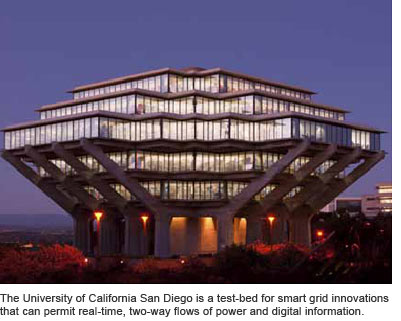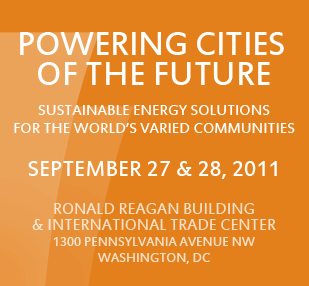By Larisa Dobriansky
 As climate change, energy security and sustainable economic development goals proliferate, smart grid technologies are offering new solutions to our nation’s most pressing challenges. As climate change, energy security and sustainable economic development goals proliferate, smart grid technologies are offering new solutions to our nation’s most pressing challenges.
Cutting-edge pilot demonstrations across the United States are testing new smart grid functionalities to address more cost-effectively such growing concerns as rising greenhouse gas emissions; our power system’s vulnerability to natural disasters, cyber attacks and energy supply disruptions; and the excesses of urbanization and the limits of growth.
These pilots, which are fusing power, information and communications capabilities, are showing how the deployment of smart grid technologies can help to redefine the organization of our power supply chain and enable all electric resources, including local energy and demand-side resources, to contribute to an efficient, affordable, reliable and sustainable electricity network.
The University of California San Diego (UCSD) is one such test-bed for smart grid innovations that can permit realtime, two-way flows of power and digital information from “source to sink” and extend the boundaries of electricity investments through the meter.
This pioneering project, which is funded by the California Energy Commission with matching contributions from UCSD’s energy efficiency program collaborators, is demonstrating smart grid’s focus upon optimal infrastructure investment and efficient and intelligent energy management toward a next generation power system.
In particular, this publicprivate partnership is revealing the potential of smart grid technologies to shape a new role for clean distributed energy in the transformation of our electricity grid.
In its pilot, UCSD is demonstrating the use of “master controller” and optimizing software technology to increase significantly the market value of its micro-grid investments in such distributed energy resources as onsite renewable generation, distributed generation, a combined cooling, heating and power system, electric vehicles and thermal and electricity energy storage.
In employing the master controller technology with the optimizer-scheduleraggregator software, the University will be able to combine, from any source within its micro-grid ecosystem, distributed generation, storage and loads into a “virtual power plant” that is fully dispatchable in the organized capacity, and real-time energy and ancillary services power markets.
This capability will allow UCSD to determine which sources of power and load control to employ and when in order to assure optimal performance, energy efficiency and overall reliability within its micro-grid system and to provide measurable and verifiable support to the grid.
In this way, this demonstration, like other ongoing pilots, is challenging with a new strategic approach, enabled by smart grid, the traditional “build and grow” utility paradigm of creating additional central power station capacity to meet increasing, massive peak demands that occur for a few hours each year.
It also is addressing the current situation in which distributed energy resource applications are undertaken in random and uncoordinated ways that yield environmentally and economically sub-optimal results, with assets financially constrained by “behind the meter” economics.
Building upon its communications assets and advanced metering infrastructure, UCSD will be able to develop, manage and deploy systemically and dynamically distributed resources within its campus in response to energy price signals and market conditions in real-time, both to meet most of the University’s energy needs, as well as to benefit the grid through better balancing of supply and demand, more optimal asset utilization and active load management and demand reduction.
Without a doubt, this pilot will generate invaluable lessons regarding the use of smart grid technologies to integrate in real-time both supply and demand assets to meet customer demand for energy services; to contribute to the “true costing” of electricity services; and to changing the value proposition of distributed energy resources from just complementing baseload generating capabilities of utilities on an as-needed basis to providing customer solutions for addressing onsite energy needs for clean, reliable and affordable power and thermal energy.
However, shifting to a more customer-driven electricity system, with cost-effective and strategic distributed energy resource applications and increased end user-controlled power management, is fraught with significant barriers and risks that will need to be overcome to preserve grid stability and power quality.
In connection with its “Smart Grid Demonstration Initiative,” the Electric Power Research Institute (EPRI) has made addressing these barriers and risks, which range from technical and economic to institutional and consumer behavioral types of barriers, central to its pilot work.
As EPRI has noted, technically there is a lack of infrastructure and accepted standards and protocols to aggregate and automate reliably distributed energy into our power system. Economically, a business case will need to be made to justify such integration and the design of pricing and incentive structures to motivate sufficient response from distributed resources that are not within the control of utilities.
And institutional barriers will need to be confronted in order to better link wholesale with retail electricity markets and replace organizational and technical “silos” with systems approaches for achieving “end-toend” integration, from wholesale to retail markets and down to end-use.
In facing these daunting barriers, constructive partnerships between utilities, communities and other stakeholders are critical. The lessons, methods and technologies of pilot demonstrations such as UCSD’s will need to be transferred and validated within the dynamic context of our electricity system, as well as within the infrastructure and built-environment of our communities.
Moreover, the efforts of utilities and local and regional governmental authorities will need to be mutually reinforcing to bring about a shift in how market success is measured, from providing reliable and affordable megawatts to “value creation,” as customer needs are addressed in increasingly efficient, differentiated and intelligent ways.
In terms of developing the market for distributed resources using smart grid technologies, both utilities and local and regional governments will need to work together to leverage their unique positions, within their service areas and jurisdictions respectively, to educate consumers about the potential benefits of a smart grid, grow consumer acceptance and new relationships, and stimulate active participation with respect to expanding choices.
To achieve the economic, reliability and environmental objectives of a smart grid “eco-system,” utilities and communities will need to interact with stakeholders in new ways to design and implement innovative and cross-cutting programs for capturing greater energy efficiency, sustainability and carbon emissions reductions. This will require the understanding of one another’s planning and decision-making processes and using new tools and methods for evaluating the cost-effectiveness of alternative options.
Understanding and using smart grid technologies can facilitate the design of more energy and resource efficient communities and contribute to transforming local infrastructure.
However, this will require integrated planning that involves utilities, municipalities and all relevant stakeholders. This integrated planning will use “energy” as a means to assess how different sectors interact (electric, gas, water, transportation, and the built environment) in order to evaluate how energy performance and environmental quality could be substantially improved within a smart grid eco-system.
In this regard, utilities can offer critical decision support tools and methods for incorporating energy supply and demand and infrastructure analyses of alternative sustainability and resource development options into existing regional housing, land-use, water supply and wastewater, transportation, waste recycling and reuse and other municipal decisionmaking
processes.
Larisa Dobriansky is a member of the National Energy Center for Sustainable Communities and director of the Global Energy Network. Previously, she was deputy assistant secretary of energy for national energy policy at the U.S. Department of Energy.
|


